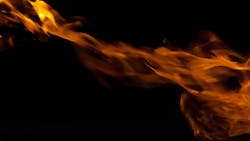It’s easy to forget the risks posed by fire if we don’t ever see them happen; we assure ourselves that a fire won’t happen in our workplace. But workplace fires are more common than some may realize, and more often than not are caused by a mistake that could’ve been easily prevented.
In 2013-2014, there were 22,000 fires, 1,803 non-fatal casualties and 17 fatalities in non-domestic buildings. These fires not only harmed and took the lives of many people, but also damaged businesses as a whole.
Often, businesses never fully recover from a fire.
Don’t let your workplace be a part of these statistics. Don’t let negligence be the downfall of your organization. Familiarize yourself with the common causes of fire and fire safety duties so you can be vigilant in preventing fires on a daily basis.
Faulty Electrics
Faulty electrics are a common cause of fires in non-domestic buildings. Virtually every workplace uses some form of electrical equipment – all of which carry a source of ignition.
Loose or frayed wires, defective or broken plugs, overloaded sockets or old, faulty equipment are tempting fate to start a fire and should not be ignored. One stray spark could set alight a carpet or desk, or a discarded piece of paper or cardboard could find its way next to an overheated plug that’s ready to ignite the first combustible item it touches.
Prevention
Every workplace has a legal duty to carry out regular inspections and ensure all electronics are maintained, are in full working order and do not pose a risk of fire.
Prevention techniques:
- Check that outlets are not overloaded, overheated or shorted.
- Check for faulty or frayed wiring.
- Check for plugs that rattle or have loose covers.
- Keep combustible objects, e.g. paper, fabric, and plastics, away from electrical equipment.
- Do not exceed any specified wattages or voltages.
- Ensure equipment is installed safely and regularly inspected by users and competent people for faults.
- Ensure Portable Appliance Testing (PAT) is carried out.
Anyone who identifies a fault or defect in equipment should report it to a superior immediately. The equipment should be removed from use and inspected by a qualified person and be properly repaired or suitably replaced.
Winter Electronics
‘Tis the season to remember workplace safety: your workplace may have a surge of extra electronics during the winter months. Numerous portable heaters and dozens of Christmas lights draped throughout the building may increase the risks of fires by tenfold if not assessed carefully and if safe practices are not adopted.
Prevention techniques:
- Regularly check the wires and plugs of electronic heaters and Christmas lights.
- Do not use extension cords with portable heaters.
- Do not place items on top of portable heaters.
- Do not overload outlets with plugs.
- Switch off all heaters and lights at the end of the day.
- Ensure that there is at least 3 feet of distance around heaters; they should not be situated near furniture or combustible materials.
- Purchase heaters that include safety features, e.g. time safety switches that prevent them from overheating or turn them off after a certain duration/if they fall over.
Collecting Combustibles
One of the key components required to start a fire is a source of fuel. Combustible materials, such as paper, cardboard, plastics or fabrics are all examples of this, and shouldn’t be allowed to amass on site. One stray ember or spark will easily send a stockpile of flammable materials up in flames that will burn and spread rapidly.
Prevention techniques:
- Do not store rubbish on site. Store it in a designated area away from the main building(s).
- If materials have to be stored on site, keep the area supplied with adequate firefighting equipment.
- Do not allow combustible materials to be kept near fire routes and escapes or sources of ignition.
- A trained fire warden should regularly observe the workplace for any obvious hazards.
- Ensure everyone on the premises has an awareness of fire safety.
Dust Dangers
Fires might not necessarily be started in the traditional way with an ember igniting a bit of wood or fabric, however. Combustible dusts, such as those created by wood, plastic and metal operations, as well as food handlers’ use of flour, can cause a build-up that, if ignited, will explode and immediately set a building ablaze.
Prevention techniques:
- Areas where operations that create dust take place should have sufficient ventilation, not be too enclosed and be kept at a safe distance from sources of ignition.
- Good work practices that minimize the generation of dust or powder should be adopted. Good housekeeping should be maintained to minimize build-up.
- Vacuums approved for combustible dust collection should be used.
Discarded Cigarettes
Jeopardizing the safety of dozens or potentially hundreds of people by inadequately extinguishing and carelessly discarding cigarette butts is a huge risk.
A number of workplace fires are caused by discarded cigarettes.
This could also be a problem during colder seasons that make smokers creep closer to the warmth of doorways, rather than stay at a safe distance from the building. If your workplace has a smoking policy that states people can only smoke in designated areas, the weather isn’t grounds to break it.
Prevention techniques:
- Having proper cigarette disposal bins in designated smoking areas.
- Having the designated smoking area situated far from main buildings and flammables.
- Having smoking guidelines with which everyone is familiar.
If everyone uses these, and numerous other, prevention techniques, fires won’t be given an opportunity to start. A strong understanding of what could cause a fire in their workplace will enable people on the premises to easily prevent fires from breaking out and keep everyone safe.
Liz Burton is a training course author for High Speed Training and a health and safety specialist. She writes educational materials about a wide range of topics, but specializes in fire safety and Personal Protective Equipment.
